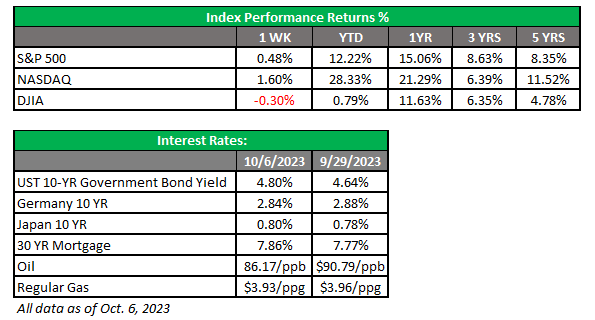AE Wealth Management: Weekly Market Insights | 10/1/23 – 10/7/23

Weekly Market Commentary
THE WEEK IN REVIEW: Oct. 1-7, 2023
The market, jobs, economy and the Fed
Markets continued to slump last week as bond rates hit levels we haven’t seen in 16 years. Suddenly, a five-year treasury yielding 4.7% isn’t so bad when compared to the volatility of the stock market.
Whether we like it or not, much of the market is based on feelings; sure, they give it fancy terms like “market sentiment,” but that’s saying the same as mood — and the current mood seems to be bad. People are on strike, from auto workers we rely on to make the cars we use to get around, to health care workers we rely on to keep us healthy and actors we rely on to entertain us. So why should markets be in a better mood? If we don’t feel well, can’t get around or lack entertainment, why shouldn’t we be cranky?
Lots of people have exhausted their savings and run up their credit cards, so they can’t even get satisfaction from buying something they don’t really need. It all feels off. The economy is still moving along, but for how long? In general, interest rates are grinding things down, personal debt is climbing, wages aren’t keeping up with inflation and hours are being cut back.
The ADP® employment report added a measly 89,000 jobs in September, far short of the consensus estimate and nearly 100,000 less than the revised August number. But on Friday, the Bureau of Labor Statistics (BLS) employment situation report (also known as non-farm payrolls) for September came in at 336,000, blowing away the consensus estimate and significantly higher than August. Meanwhile, the unemployment rate stayed at 3.8%.
Will these numbers stay the Federal Reserve’s hand at their next meeting? Or will it give them the green light to continue to dither and possibly drive us into a recession, reversing a promising year? Perversely, markets finished the week up, even as the treasury yields that caused concerns in prior weeks rose as well. It will take a few days for markets to fully digest the recent jobs data, but it feels like we’re watching a trainwreck developing in front of our eyes in slow motion.
Burning down the house
Ever wonder why Congress has such a low approval rating? According to Gallup, only 17% of respondents said they approved of the way Congress is handling its job in September. Granted, that was last month when the government was on the verge of a shutdown, so maybe that explains the dismal approval rating. But the problem with that logic is that the last time Congress had a favorability rating of 50% was June 2003 — 20 years ago!
Last week, a small group of Republicans seemed to blow up the House of Representatives and throw the government into a new state of turmoil when they forced a vote to remove Speaker Kevin McCarthy over the budget dust-up — the first time ever a House speaker has been booted from the position.
We’ve previously said there would probably be fewer (or lower) hurdles to jump in the second half of 2023 and that markets would likely push higher, but these self-inflicted wounds seem to be getting to be too much. These mind-boggling miscues are coupled with the Fed fixated on lowering inflation. Higher rates are giving people options they didn’t have in a zero-rate environment, which is coming at the expense of equities. As long as rates remain at these levels, the cost of doing business will remain higher and earnings will suffer. Plus, the market will likely limp instead of roar into the year-end and a promising year will have been frittered away.
The government also should stop spending; we have added over $10 trillion to the deficit since 2019, without any tangible benefits. We spent money we did not have on things we did not need. The solution seems to be simple: Curtail government spending, which will help lower inflation and allow the Fed to back off. That, however, would require leadership, not politics.
Coming this week
- We’ll see wholesale inventories on Tuesday. On Wednesday, we’ll get the latest producer price index (PPI) numbers, which will play heavily in the Fed’s decision whether to raise rates or stay put at their next meeting.
- Minutes from the last Fed meeting will also be released on Wednesday, while mortgage applications will round out the day.
- The second inflation shoe will drop on Thursday, with the September consumer price index (CPI) providing further data for the Fed.
- Friday will be quiet, with the October preliminary reading of consumer sentiment released.

AE Wealth Management, LLC (“AEWM”) is an SEC Registered Investment Adviser (RIA) located in Topeka, Kansas. Registration does not denote any level of skill or qualification. The advisory firm providing you this report is an independent financial services firm and is not an affiliate company of AE Wealth Management, LLC. AEWM works with a variety of independent advisors. Some of the advisors are Investment Adviser Representatives (IAR) who provide investment advisory services through AEWM. Some of the advisors are Registered Investment Advisers providing investment advisory services that incorporate some of the products available through AEWM.
Information regarding the RIA offering the investment advisory services can be found at https://brokercheck.finra.org/.
Investing involves risk, including the potential loss of principal. No investment strategy can guarantee a profit or protect against loss in periods of declining values.
The information and opinions contained herein, provided by third parties, have been obtained from sources believed to be reliable, but accuracy and completeness cannot be guaranteed by AE Wealth Management.
This information is not intended to be used as the sole basis for financial decisions, nor should it be construed as advice designed to meet the particular needs of an individual’s situation. None of the information contained herein shall constitute an offer to sell or solicit any offer to buy a security or insurance product.
10/23-3143466-2
